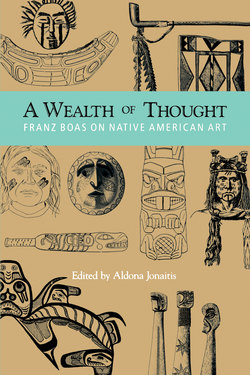Читать книгу A Wealth of Thought - Boas Franz - Страница 10
На сайте Литреса книга снята с продажи.
Оглавление1. Tattooing of the Haida
This brief note on Boas’s presentation to the New York Academy of Sciences on Haida tattooing includes an early statement by Boas on his belief that the Kwakiutl originated some motifs which the Haida developed to the highest stage.
Stated Meeting.
The President, Dr. Newberry, in the chair.
Thirty-five persons present.
Dr. Franz Boas exhibited a number of photographs of tattooed Indians from the Queen Charlotte Islands, B.C. This people, the Haida, are the only ones in the habit of tattooing their whole bodies—wrists, arms, breast, back, legs, and feet—the designs being conventional representations of animals, the “crest” of the person on whom they are tattooed. The tattooing is done by puncture and by rubbing soot into the wounds. The patterns are exactly analogous to the paintings and carvings of those people. Tattooing is not unknown to the neighboring tribes, but chiefly confined to marks on the wrists and eventually on the ankles. Such designs are found, for instance, among the Tsimshian. Tattooing on the arm and breast is also found among the Nutkas [Nuu-chah-nulth] of the west coast of Vancouver Island, but in this case it is connected with religious practices, not with the social organization—the totems of the people—as it is among the Haidas. A photograph of a Nutka was exhibited, showing a human figure on the breast. The same individual had long, parallel cuts running from the collarbone down to the belly, and from the shoulders all along the arms. These wounds are inflicted at the initiation of the young man into a secret society and are called “Tlo-koala,” a word borrowed from the Kwakiutl language.
Besides these photographs of tattooed men, others illustrating a few types of Indians were shown, and attention was called to the broadness of their faces, the light color of their skins, and the shortness of their heads. Deformed heads are found only as far north as Milbank Sound and Gardner Channel. A few photographs of excessively deformed heads from the north point of Vancouver Island showed the effects of bandaging, which results in a great elongation of the occipital part of the head.
Replying to a question of the chairman, Dr. Boas stated that the style of art of the northern Tlingit, the Haida, Kwakiutl, Nutka, and Salish can be easily distinguished. He believes that certain designs originated among the Kwakiutl, but reached their highest stage of development among the Haidas. The Salish have some peculiarities not shared by any of the other tribes.
The President referred to his own observations on the carvings among some twenty tribes of that region, and to the artistic skill displayed by those along the coast, whose work bears a decided resemblance to that of the races of Central America—possibly indicating a genetic relationship—and contrasts strongly with the inferior skill in carving shown by the inland tribes of our Northwestern territory.
Reprinted from Transactions, New York Academy of Sciences, pp. 115–16, 1889.
